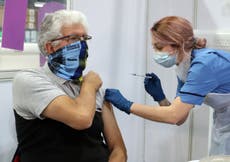Covid infections fall by more than two-thirds but ‘remain high’, study shows
Latest React report has England’s R number at 0.72 but stresses rates are as ‘high as September 2020’
Coronavirus infections fell substantially from January into February, new figures show, but prevalence remains high in England.
The research, which saw 85,437 swab tests carried out across the country between 4-13 February, showed that cases of Covid-19 had dropped to just one in 200 people testing positive.
It also concluded England’s R number is now 0.72 and the number of infections is halving every 14.6 days.
The interim findings, from the first half of Imperial College London’s ninth React study, advise the “prevalence of infection in the community” in England was 0.51 per cent, a drop of more than two-thirds since the last such report in January 2021 – when 1.57 per cent of people tested positive.
Follow Covid live: Lockdown takes effect as infections fall and Kent variant ‘stays in body longer’
While the results have not yet been peer-reviewed, early indications suggest stay-home measures have caused a “strong decline” in cases of coronavirus among England’s general population five to six weeks into lockdown.
But “prevalence remains high”, researchers warn, currently at levels similar to those seen in late September 2020. Plus, the number of Covid cases in hospitals is actually higher now than at the peak of the first wave in April 2020.
The experts added the effects of easing social distancing need to be closely monitored to avoid a resurgence in infections and renewed pressure on health services.
Reacting to the results of the study, Imperial College’s Steven Riley, said: “This is good news. This is a better decline than many people would have hoped for, certainly when we were thinking about this at the end of December.”
The professor of infectious disease dynamics pointed to the study’s “note of caution”, though, and said “clearly there’s still a lot of pressure on hospitals, both in terms of number of new admissions, and in the total number of people in hospitals”.
“So, the trend is great, but because prevalence is high, there essentially isn’t a lot of headroom … because if for any reason, we do return to growth then we’re immediately at levels of hospital pressure the same as in the peak of the first one,” he told Press Association.
Matt Hancock said the findings showed “encouraging signs infections are now heading in the right direction across the country” but warned “we must not drop our guard”.
“Over 20,000 Covid-19 patients are in hospital so it is vital we all remain vigilant and follow the rules as our vaccination rollout continues at pace,” the health secretary said.
Meanwhile, Professor Paul Elliott, also of Imperial College, said “a lot of encouragement” could be taken from the decline being seen but “we’re not out of the woods yet”.
“Because the prevalence is still one in 200, and that obviously masks some differences in different areas and between different groups of people.”
The study found that while prevalence in total was lower across all nine English regions, declines were smaller in the northwest, northeast, and Yorkshire and the Humber.
London, the southeast and the West Midlands saw the greatest declines in England, with occurrences of Covid falling by around 80 per cent in each.
Prevalence also fell substantially across all age groups with the highest rates among 18 to 24-year-olds at 0.89 per cent, and those aged five to 12 years at 0.86 per cent.
“It’s reassuring that the reduction in numbers of infections occurred in all ages and in most regions across the country,” Prof Elliott said.
“While the trends we’ve observed are good news, we need to all work to keep infections down by sticking to the measures which are designed to protect us and our health system.”
Asked if he thought the React report could see the UK eased out of lockdown, Prof Elliott told the PA news agency only that there must be a “very delicate balance”.
It comes as Boris Johnson announced on Wednesday that lockdown would be relaxed “cautiously” and in “stages”, but refused to give more detail.




Join our commenting forum
Join thought-provoking conversations, follow other Independent readers and see their replies
Comments